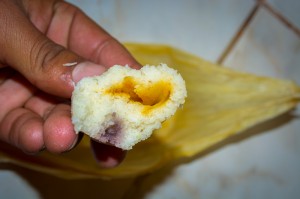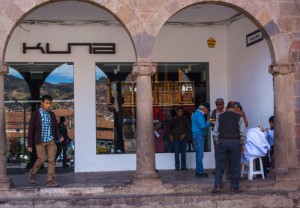Cuzco and its Wonderful Tamales Have Changed

Some years ago, when I was still a child, Cuzco was different. There were large hectares of fields on the edges of the city. There the people of Cuzco would plant crops to raise their own food.
In those days, the Imperial City was still tranquil. It did not have as many people and those who lived here would spend time on the many green pastures enjoying an outing. They would lie out on the grass and with a peaceful feeling receive the rays of the sun to warm them.
Some of Cuzco’s streets were not paved and there was still no electricity in many neighborhoods. The public transport buses would circulate in the center of town while the people who lived on the hillsides had to walk to get to markets. They would go and come while breathing pure, mountain air.
Our food was as delicious as it is today, though there were dishes that few people prepare any more. Maybe they have forgotten the recipes of the foods our grandmothers would feed us.

My grandmother would make wonderful tamales from corn. How can I forget her hand mill which she would make us work for hours to grind enough corn so that the next day we would have tamales to eat along with a cup of coffee to wash them down while we all conversed about whatever was going on in those days.

I lived for a while with my great, great grandmother who was eighty-five years old at the time. Every afternoon and night I got to listen to her tell the experiences she had in her childhood and her youth. I thought all that she told me was unimaginable.
She was the first person to tell me about the condenados and the machos (both kinds of living dead) and other demons that I had never seen. At night, though, with her I did hear the cries of some souls that were suffering after death. She told me they were in pain because they had done a lot of harm to others when they were still alive and they had to pay their debt.
She told me many incredible things. Sometimes I could not sleep from thinking about all that she told me. Her stories filled me with emotion.
In those days we did not eat pizza or pollo a la braza (rotisserie chicken). We had lunches that were made from our harvests. In those days everyone who lived on the hillsides above the city could still farm. There was open land. People were very cordial and would help each other. There was a lot of trust.
Our fiestas were carried out with a lot of joy. Like today, they followed the calendar, but it seemed there were not as many activities that followed the formal, instead of the religious, calendar.
We would celebrate birthdays of our family members. The women of the house would first trap some guinea pigs, maybe some hens, and then they would work their magic and feed us wonderful dishes with natural seasonings. We would all have a good time, with good food and our Andean refreshments, chicha and frutillada (strawberry chicha). We did not carry a lot of money but we were happy and enjoyed ourselves from day to day.

Time passed and those marvelous days are now kept in a trunk of memories. Today, if I wish to enjoy a tamale I have to go to the corner of the Plaza de Armas, our main square, where a woman sell delicious tamales of two kinds, sweet and salty, to the people passing by.
Tamales are still eaten in Cuzco as an appetizer or as a dessert. You can enjoy them at any time. They are made from the best grains of corn. To make them, the women who sell them use their own recipes. They will not share them with any one. You will hear the vendors talk about women who take their recipes with them to the grave so that my clients will always remember and miss me.
Tamales seem so simple, yet they are complex. You just have to try one to know how they enrich your palate and make your stomach happy.
They are very recognized and demanded. People will contract for large numbers of tamales for parties, feasts, or obligations. Whenever a fiesta comes along the tamaleras, those who make and sell tamales have lots of work. It is not uncommon for them to have to make more than a thousand tamales.

They first have to select fine grains of corn to then work their magic and end up with little, warm miracles packaged in cornhusks.
The price of tamales is one sol per tamale. At this price you can always enjoy one or more. Tamales appear in the street beginning around eight in the morning. You can find them throughout the city, if you ask. You recognize the tamale vendors because they wear a white apron and a white cap. They sit in front of a large pot which holds their tamales. They will cover it with white cloth to keep the tamales warm. They tend to be very friendly and warm with their clients who day after day consume their tamales.




